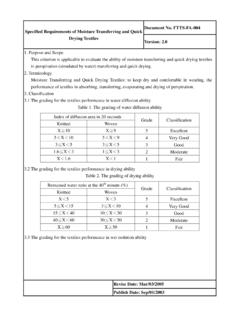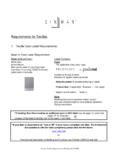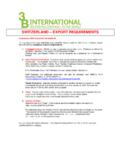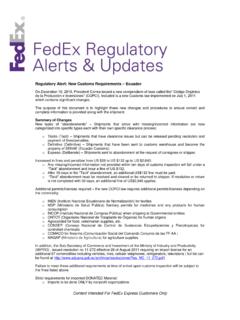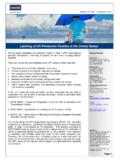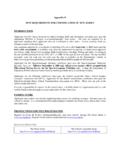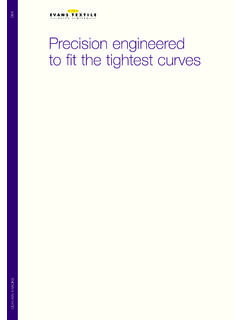Transcription of Document No. FTTS-FA-009 Specified …
1 Document No. FTTS-FA-009 . Specified requirements of antistatic textiles Version: and Scope This criterion is suitable to any kind of textiles including woven, knitted, coated/laminated textile and nonwoven textiles . The durability of antistatic may apply repeated washing and weathering test if necessary. Insulative Material: Surface resistance >1 1011 , or surface resistivity > 1 x 1012 /cm2. Static Dissipative Material: Surface resistance between 1 104 and 1 1011 , or surface resistivity between 1 105 /cm2 and 1 1012 /cm2. 3. Classification Grade and classification Table 1. Frictional-charge classification Frictional-Charge Electrostatic (Volt, V).
2 Grade Classification Knitted / Woven Warp/ Filling V<100 3 Excellent 100 V 500 2 Good 500 V 1000 1 Fair Table 2. Surface resistance classification Surface Resistance (Ohms, ) Grade Classification 1 x 104 1 x 106 3 Excellent 6 9. 1 x 10 1 x 10 2 Good 9 12. 1 x 10 1 x 10 1 Fair Table 3. Static dissipative classification Static Dissipation (Second, S) Grade Classification S 3 Excellent S 2 Good S 2 1 Fair General Requirement Table 4. General requirement of antistatic textiles Item General Requirement Testing Standard A. AATCC 135(1)III(A)ii method for woven, Original, coated/ laminated and nonwoven Durability 20 times washing, or B. AATCC 135(2)III(A)ii method for knitted 50 times washing(1).
3 C. Refer to JIS L0217-103 method(2). Revise Date: Mar/03/2005. Publish Date: Aug/03/2004. Document No. FTTS-FA-009 . Specified requirements of antistatic textiles Version: Remark:(1) Durability can also refer to buyer's requirements (2). Surface resistance and Surface dissipation refer to AATCC 135; and Frictional-charge eletrostatic refer to JIS L0217-103. Method Frictional-Charged electrostatic potential measuring method Test condition: Tests should be carried out at 20 2 and 40 2 % RH; other relative humidity and temperature may be used for special requirements . Sample preparation: Take 20 test specimens, each in 50 mm (2 in.) 80 mm ( in.)
4 , from the sample. 10 pieces should be taken along warpwise direction and fillingwise for another 10. Pretreatment: condition the test specimens before testing for at least 24 hours under the atmosphere of 20 2 and 40 2 % Apparatus and material: friction-charged electrostatic potential measuring apparatus and rubbing cloth (according to JIS L1094). Procedure: (1) Take 20 rubbing cloths (cotton and wool), each in 150 mm (6 in.) 25 mm (1 in.), 10 along warpwise and another 10 along weftwise. (2) Wash the rubbing cloths according to the washing condition Specified in JIS L 0217-103 method before testing. (3) Fix the test specimen to the frame (treat face side as the rubbing side), rotate the rotary drum in a speed of 400 rpm to rub the test specimen.
5 Measure the electrostatic potential given when 60. seconds elapsed after starting rubbing. Replace the test specimen and rubbing cloths, repeat this procedure on 5 test specimens along warpwise/wale direction and weftwise/course direction respectively. (4) If the technician uses the cotton rubbing cloths in the 1st test, then use wool rubbing cloths for the 2nd test. (5) Before attach the specimen on the frame, adhesive tape should be put on the holding frame. Electrical Surface Resistivity Test There are two types of test, described as below: (1) Type I electrical surface resistivity test (according to AATCC 76): applicable to fabric.
6 (2) Type II point to point electrical surface resistivity test (according to ESD ): applicable to garment. Test Condition: Tests shall be carried out at 23 2 and 20 2 %RH; for special requirements , other relative humidity and temperature may be used but it should be marked on the report Revise Date: Mar/03/2005. Publish Date: Aug/03/2004. Document No. FTTS-FA-009 . Specified requirements of antistatic textiles Version: Test Specimen: (1) Type I: randomly take 5 specimens in the size which is suitable to the electrodes of the particular equipment being used. (2)Type II: garment. Pretreatment: condition the test specimens before testing for at least 24 hours under the atmosphere of 23 2 and 20 2 %RH.
7 Apparatus: (1) Type I: concentric electrodes electrical resistance meter (refer to AATCC 76). (2) Type II: point to point electrical resistance meter (refer to ESD ). Remark: The resistance meter in conjuction with the electrode system should be capable of measuring values in the range of 103 to 1012. Test Procedure: (1) Turn on the main power of the electrical resistance meter. (2) 100 volt should be applied for the test voltage. (3) For type I, lay the specimen flatly and place the detector on the tested specimen; for type II, lay the garment flatly and place two detectors in both sleeves respectively. (4) Record the data ( ) from the meter.
8 (5) Repeat the procedure (1) to (4) 4 more times. (6) Calculate the average resistivity. Electrostatic Dissipation Test Test Condition: Tests shall be carried out at 23 2 and the relative humidity should be below 15 %RH; for special requirements , other relative humidity and temperature may be used but it should be marked on the report. Test Specimen: 3 pieces of specimen in the size of 125 mm (5 inches) by 75 mm (3 inches). Apparatus: Electrostatic Dissipation Tester Test Procedure: (1) Turn on the main power of the tester and preheat it for 5 minutes. (2) Place the specimen onto the tester, charge the specimen with 5000 volt, then, measure the duration by which this charged electrostatic potential attenuates to 500 volt.
9 This is the electrostatic dissipation time. (3) Record the electrostatic dissipation time. (4) Repeat the procedure (2) to (3). (5) Test 3 times for each specimens on both positive electrode and negative electrode. Record all test results and report the highest reading. Revise Date: Mar/03/2005. Publish Date: Aug/03/2004. Document No. FTTS-FA-009 . Specified requirements of antistatic textiles Version: 5. Mark Table 5. Mark of antistatic textiles Frictional-Charged Surface Type Static Dissipation Grade Classification Electrostatic Resistance I 3 3 3 AAAAA Excellent II 2 2 2 AAA Good III 1 1 1 A Fair 6. Reference JIS L1094: Testing Methods for Electrostatic Propensity of Woven and Knitted Fabric AATCC 76: Electrical Resistivity of Fabrics FTM STD 101C, Method 4046: Electrostatic properties of Materials ESD : ESD Association Standard Test Method for the Protection of Electrostatic Discharge Susceptible Item Revise Date: Mar/03/2005.
10 Publish Date: Aug/03/2004.
